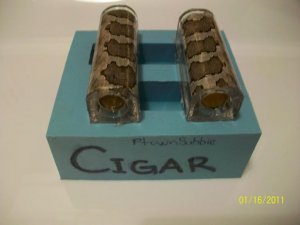My apologies for such a vague answer. My experience with the molds that have the nipples that stick into the tubes is this: It appears to me as though the ends of the tube are not completely plugged. Well, they are, just not tight enough to prevent any air from escaping. This is by no means a "Knock" on Charlie's molds, but merely a comment that they do not work for me. I have invested tons of time trying to figure out the best method of casting my snakeskin blanks, and have just recently done so. I have tried to use syringes to suck the air out of the tubes, plugging with play-doh, packing with BB's, using corks and applying CA where the tube meets the cork. It feels as though i have tried everything. So back to the question, in my trials with (for lack of a better word)nipple molds, air has escaped and traveled along the skins causing the silvery, or trapped air appearance. Now, not everytime was the air that escaped that bad, but in my book, it is still not acceptable to use as a blank. So I changed to a different plugging method and mold design and began pre-heating the molds and the resin and the results are astonishing! Maybe I just dont fully understand the proper way of utilizing the resin saver molds. Anyway, I will reiterate that this is no way a Knock or discouragement to buy these molds, but merely an opinion of choice with regards to casting methods. I hope that I have in no way, offended anyone's technique or products.

Not so much offended as concerned.. and bubbles have plagued casters
(of pretty much anything, not just resin or pen parts) forever. But I
haven't had the problems you describe, or not the way you describe them.
The stoppers (nipples) are oversized slightly to fit tight. In fact, too tight
is bad, because they can get cut on sharp tube edges. That hides resin,
which cures and in turn, traps the cut silicone. So the silicone can tear
when you de-mold. So I had to be careful not to make them TOO tight.
But no way should they be undersized.
I'm not sure why air should escape at all.. you don't want to suck the air
out of the tubes, nor do you want to pressurize to the point where you
are putting pressure on the stoppers. The pressure inside and outside of
the tubes should be the same, whether it is vacuum (not recommended)
or pressurized. (should be low pressure) but MOST IMPORTANT is that
this pressure should NEVER CHANGE while the resin is in the liquid state.
Once the resin is poured, the pressure inside and outside of the tubes
is equalized. If you pressurize to high, you force resin into the tubes. If
you pull a vacuum, you will draw the air out of the tubes and through the
resin. But, if the pressure changes, you reverse this process.. except that
the tubes are now under the liquid. So if you lose even a tiny bit of vacuum
that space inside the tubes will be replaced with resin. And if you lose
pressure you will draw air back out of the tubes.
My experience with the silvery shimmer was that a couple of things can
cause it. One is the material. Paper, skins and such .. they hold air. LOTS
of air. This air likes to come out when the resin gets nice and warm. But
that's not where I had the most problem.. it was that I was trying to turn
the blanks too soon.
Resin that is hardened but not fully cured is still pliable. A little soft, a little
rubbery .. and you put it on a lathe and make it spin fast. Then you put
a sharp tool up to it, and the lathe is trying to make it go while your tool
is trying to make it stop. That torque will give you the silvery shimmer.
It twists the resin like a piece of licorice .. and it separates the resin from
the tube. Not very much, it's just a little. But the silvery part is an air space.
Out of habit now, I just demold and put them aside for a day or so.
As for pre-heating the resin and the molds.. I'm all for that. I always do
both. It just makes everything go smoother. Bubbles don't stay in the
resin, they rise to the top. And there's less of them. Plus everything sets
up much faster.
anyway, I got long winded here.
If you're having trouble with the ResinSavers leaking, take a look at the
stoppers and see if they're damaged. If they get cut or torn, you'll have
trouble. They can be repaired. But if you've had this trouble all along, then
get them back to me so I can see what's going on. I made them and I'll
stand behind them. the trouble you're describing shouldn't be related to
the mold but if it is, let me correct it.
These molds have evolved because of feedback from users. (trust me..
you wouldn't believe what the first one looked like..) If there are problems
that can be solved it makes no sense to keep making them 'wrong' ..

